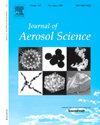气溶胶特征二维分布的直接反演
IF 2.9
3区 环境科学与生态学
Q2 ENGINEERING, CHEMICAL
引用次数: 0
摘要
气溶胶分类器允许根据质量、迁移直径或空气动力学直径分布来描述粒子群。当这种分类与第二层分类相结合时,可以检索到二维分布,从而对气溶胶特性的分布提供额外的见解。二维分布通常从与测量相关的广泛数量(例如,粒子质量)转变为提供更直观的粒子形态见解的密集数量(例如,有效密度或黑碳质量分数)。此外,大多数广泛的性质彼此之间高度相关(例如,粒子质量和迁移率直径)。这使反演变得复杂,导致检索到的分布比真实分布宽得多。在这项工作中,我们表明,这些问题可以使用单个分析步骤来解决,以密集性质为术语来计算兴趣分布。这产生了一种直接的反演方案,它(1)避免了对检索公共兴趣分布的后处理的需要;(2)降低了定义了二维分布的气溶胶特性之间的相关性;(3)使规范化更容易、更客观;(4)将最小可分辨分布宽度提高了96%。该方法使用模拟分布(幻影)和实验数据进行了演示。本文章由计算机程序翻译,如有差异,请以英文原文为准。
Direct inversion for bidimensional distributions of aerosol characteristics
Aerosol classifiers allow particle populations to be described in terms of mass, mobility diameter, or aerodynamic diameter distributions. When this classification is combined with a second layer of classification, a bidimensional distribution can be retrieved that provides additional insights into the distribution of aerosol properties. Bidimensional distributions are often transformed from extensive quantities related to the measurement (e.g., particle mass) to intensive ones that provide more intuitive insights of particle morphology (e.g., effective density or black-carbon mass fraction). Further, most extensive properties are highly correlated with one another (e.g., particle mass and mobility diameter). This complicates inversion, resulting in retrieved distributions that are considerably broader than the true distribution. In this work, we show that these problems can be solved using a single analysis step to compute distributions-of-interest, phrased in terms of intensive properties. This yields a direct inversion scheme that (1) avoids the need for post-processing to retrieve common distributions-of-interest; (2) reduces the correlation between the aerosol properties for which the bidimensional distribution is defined; (3) makes regularization easier and more objective; and (4) improves the minimum resolvable distribution width by up to 96 %. The approach is demonstrated using both simulated distributions (phantoms) and experimental data.
求助全文
通过发布文献求助,成功后即可免费获取论文全文。
去求助
来源期刊

Journal of Aerosol Science
环境科学-工程:化工
CiteScore
8.80
自引率
8.90%
发文量
127
审稿时长
35 days
期刊介绍:
Founded in 1970, the Journal of Aerosol Science considers itself the prime vehicle for the publication of original work as well as reviews related to fundamental and applied aerosol research, as well as aerosol instrumentation. Its content is directed at scientists working in engineering disciplines, as well as physics, chemistry, and environmental sciences.
The editors welcome submissions of papers describing recent experimental, numerical, and theoretical research related to the following topics:
1. Fundamental Aerosol Science.
2. Applied Aerosol Science.
3. Instrumentation & Measurement Methods.
 求助内容:
求助内容: 应助结果提醒方式:
应助结果提醒方式:


